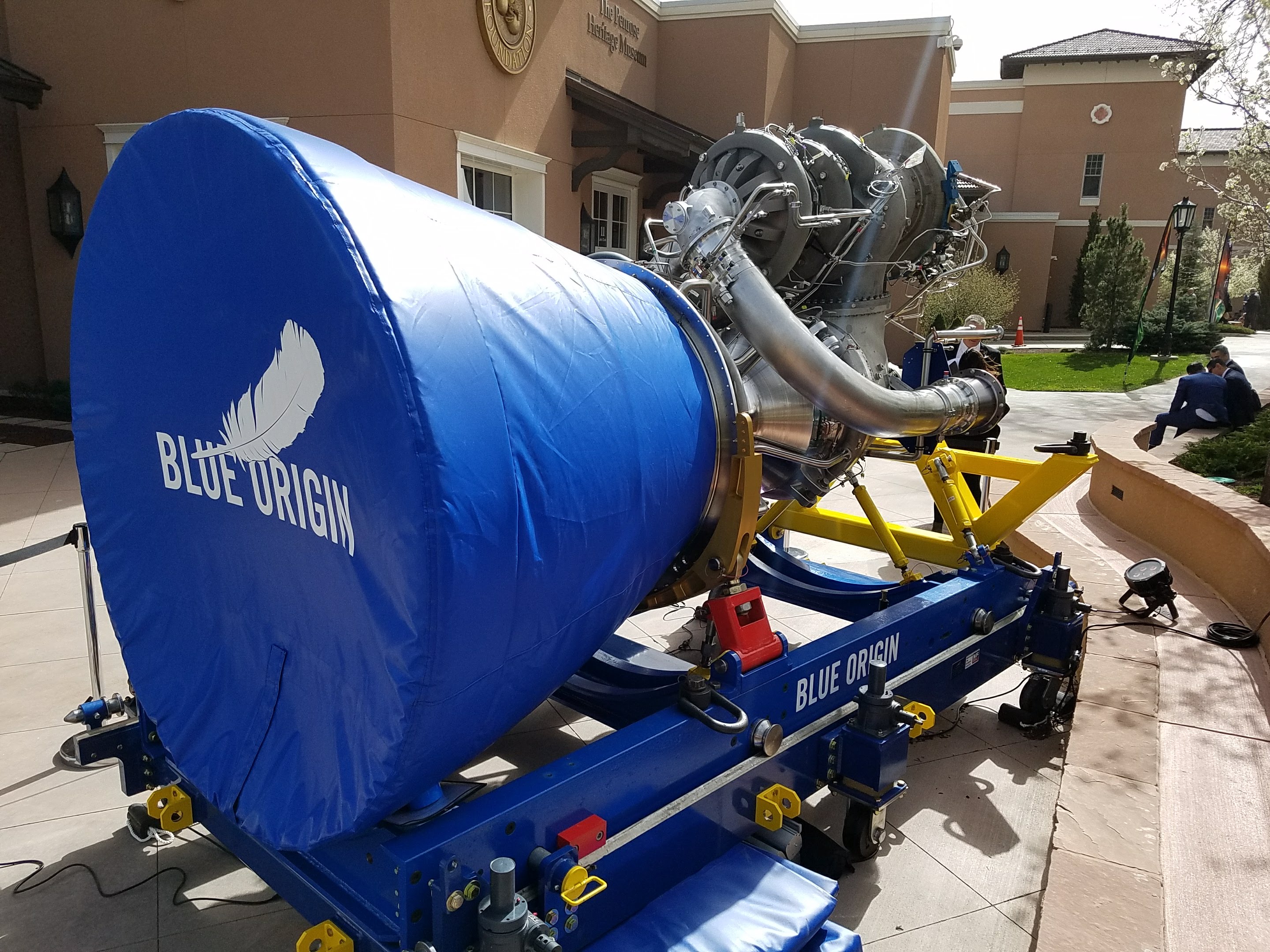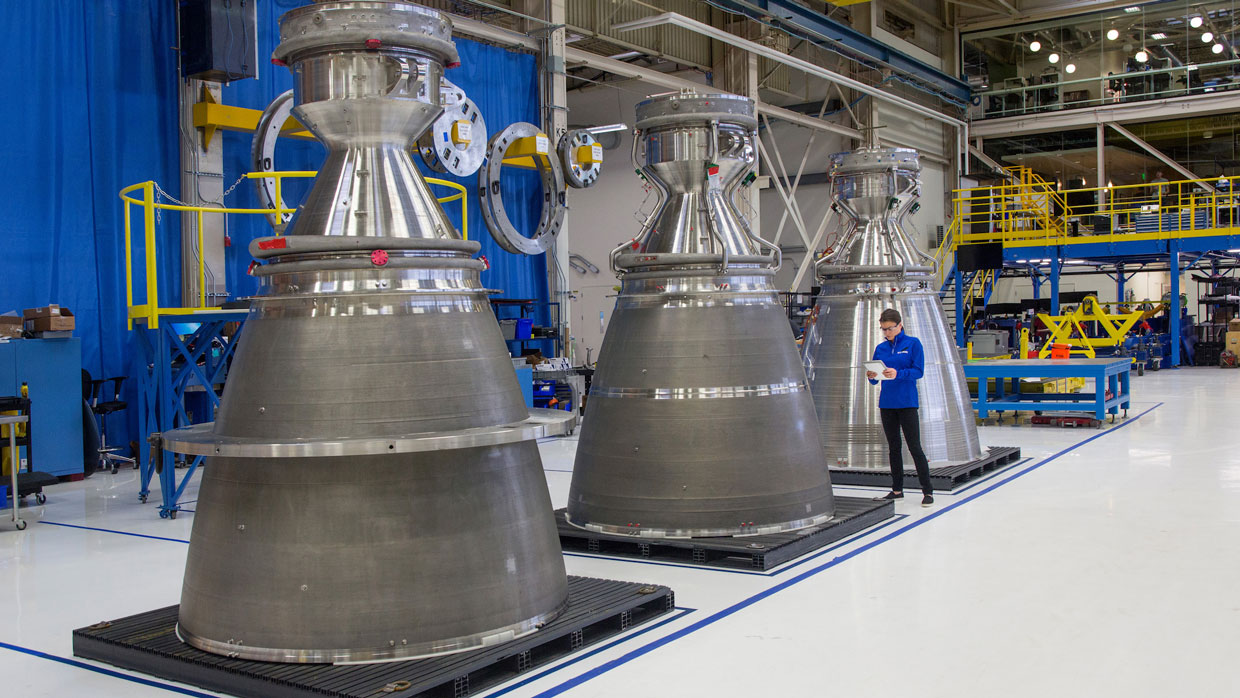
A Closer Look At Blue Origin’s Next Generation BE-4 Engine
A lot of time and effort goes into the development of a next-generation rocket engine. A powerful and efficient rocket engine can significantly increase the capabilities of practically any launch vehicle. Blue Origin has experience with the current BE-3 engine but is hard at work on the next iteration. Blue Origin’s success with the BE-4 engine will have a major impact on future launch vehicles including New Glenn, Vulcan, and more.
BE-4 is a next-generation rocket engine currently in development by Blue Origin. The goal is to create an extremely effective engine for future launch vehicles such as New Glenn. Blue Origin plans on doing this by using LNG propellant, simplifying the design, and increasing the power. Each aspect is meant to help not only improve the performance but Blue Origin’s production of the engine as well.
Blue Origin has made some unique design choices when developing the BE-4 engine. Each is meant to improve the final product. A lot of future projects of not only Blue Origin but other big companies such as ULA are riding on the success of this engine. However, the development has not been the smoothest with delays pushing the first flight test of the BE-4 back to 2022 on the Vulcan rocket.
What Will BE-4 Be Used For?

Blue Origin is planning for the BE-4 to have a wide variety of uses and customers when completed. However, there are two main applications that I want to point out. The BE-4 is planning to be the primary rocket engine on both Blue Origin’s New Glenn and United Launch Alliance’s Vulcan. These are both next-generation rockets that require a quality engine. This has been a long time coming with Blue Origin and ULA signing an agreement in late 2014 to work on and use the BE-4 engine when ready. Previously ULA has been using the Russian RD-180 engine on a lot of its launch vehicles. Specifically, Vulcan is planned to have two BE-4 engines on the first stage which are crucial for the rocket’s success.
Blue Origin is in a similar scenario with the development and future of New Glenn. New Glenn is another next-generation launch vehicle planned to use BE-4 engines. In the past, Blue Origin has primarily worked on smaller engines such as the BE-3 which is used currently on New Shepard. When Blue Origin started working on a new heavy-lift launch vehicle, they needed to develop some much bigger and more powerful engines to power it. New Glenn will use 7 BE-4 engines on the first stage providing practically all the power. Additionally, the engines will be responsible for the landing process as New Glenn’s first stage is meant to be fully reusable.
BE-4 Features
LNG Propellant – The first aspect of the BE-4 engine I want to point out is the propellant used. LNG stands for liquid natural gas and is a type of propellant. This is different from a lot of launch vehicles which use more common propellants such as kerosene. There are multiple benefits to using this type of propellant that encouraged Blue Origin to go this route. Specifically, Blue Origin mentions that they chose LNG because it is highly efficient, low in cost, and widely available. Another big reason is LNG can be used to self-pressurize its tank. This is known as autogenous depressurization, this eliminates the need for complex systems that draw on Earth’s helium reserves. This ends up helping lower the cost and avoiding taking from the scarce amount of helium in reserves. LNG also possesses clean combustion characteristics even at low throttle, simplifying engine reuse compared to kerosene fuels. This is necessary when Blue Origin plans to use all the engines and then land and reuse the entire rocket.
Simplified Design – The next important feature of the BE-4 engine is the simplified design. Blue Origin mentioned that BE-4 was designed from the beginning to be a medium-performing version of a high-performance architecture. Here Blue Origin is suggesting that they could produce a lot more power with the BE-4 design but chose to slightly limit the power produced. The reason Blue Origin did this is to lower development risk while still meeting performance, schedule, and reusability requirements. In other words, Blue Origin did not need the maximum power and efficiency out of the BE-4 engine so they are working towards what will work for future launch vehicles such as New Glenn and Vulcan.
The process of continuing to push and maximize the BE-4 engine would add additional time, money, and possible complications encouraging Blue Origin to hold off. However, Blue Origin also points out that with their hardware-rich approach, multiple developmental units and redundant test stands enable a high test tempo and rapid learning. While it would be ideal to get more power and possible efficiency out of the rocket engine through more testing, it may be in Blue Origin’s best interest to hold off due to current delays and complications with the engine.
Increased Power – The last feature of Blue Origin’s BE-4 engine that I want to mention is the increased power. As I mentioned prior Blue Origin had developed the BE-3 engine which is used on New Shepard. This engine has worked out very well for the company but is not nearly powerful enough for larger launch vehicles such as New Glenn or Vulcan. There are multiple variants of this engine, the BE-3PM generates 110,000 pounds of force at sea level. The BE-4 on the other hand is expected to produce around 550,000 pounds of force. Blue Origin points out that BE-4 is the most powerful liquefied natural gas fueled rocket engine ever developed. This is thanks to many different aspects including the engine using an oxygen-rich staged combustion cycle. This power will be necessary for large launch vehicles such as New Glenn and Vulcan. As I mentioned before, the engine is built in a specific way and uses LNG propellant partially to help with the reusability aspect. The engine is meant to be used for up to 100 flights and landings. Additionally, the engine has a deep throttling capability of 65% power or lower. This will help with launch vehicles such as New Glenn’s landing process.
BE-4 Challenges

Blue Origin’s BE-4 engine has big plans for the future but has not had the easiest and most successful development. This has also had an impact on United Launch Alliance, and their relationship with Blue Origin. After a lot of delays and previous issues, in July 2020 the first pathfinder was delivered to ULA for testing with their Vulcan Centaur. At this point in time, there were a lot of different issues with the engine. Tory Bruno the CEO of ULA pointed out that there were ongoing issues with the BE-4’s turbopumps. Additionally, Blue Origin was still troubleshooting other problems with the combustion chamber and pumps of the engine. In 2021 it became more clear that the engine program was not doing too well. A lot of delays combined with some issues including the ones I mentioned prior have hurt the program. However, Blue Origin is still working hard on the engine and is expected to have a quality finished product sometime soon.
Conclusion
Rocket engines are not only extremely complicated but they are very important as well. Blue Origin is working to make a next-generation rocket engine for multiple next-generation launch vehicles. This includes Blue Origin’s New Glenn and ULA’s Vulcan. Blue Origin is working to improve and create a powerful engine by using LNG propellant, simplifying the design, and increasing the power. The BE-4 development has not gone very smoothly over time. However, Blue Origin is continuing to work on the engine and expecting it to be ready within a short period of time. We will have to wait and see how the development continues and how the engine ends up performing.
